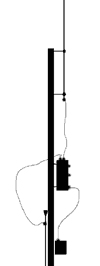
"Walking" stick
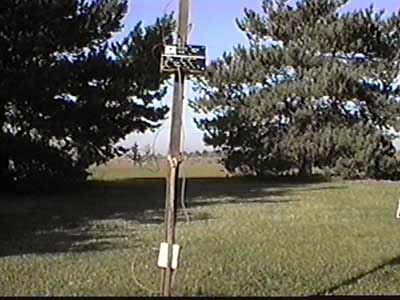
The "walking" stick is the easiest
antenna to set up. A VLF receiver is small and light
enough to be mounted onto the pole itself. It's main component
is a two by two inch square wood pole. The antenna element
(attached close to the top of the pole) is a
72 inch telescoping whip. This particular image shows the INSPIRE RS-4 VLF
receiver with the radio shack mini speaker-amplifier (the small white
box near the bottom). A four foot long copper
grounding rod staked into the soil provides vertical support.
The copper rod also serves as an electrical ground connection
to the earth. The picture also shows the receiver is setup
near the trees, which is just for display; for optimum
performance it would be located at least twice the distance of
the nearest tree's height.
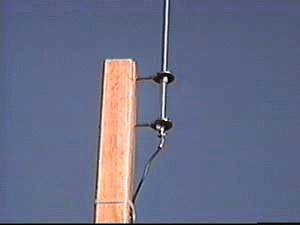
The antenna element is ingeniously attached to the pole
using twin-lead cable standoff insulators with wood screw
threads.
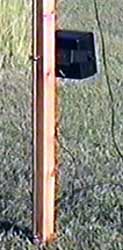 This picture shows an external speaker mounted near the
bottom of the walking stick. This picture shows an external speaker mounted near the
bottom of the walking stick.
|
|
Long wire
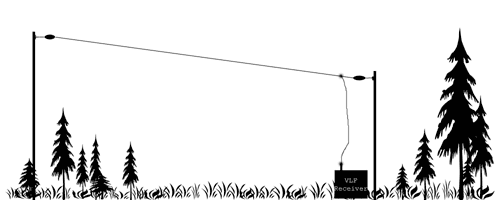
A long wire is very useful when the walking stick antenna
does not produce enough gain to hear VLF radio emissions. This
type of antenna is popular with shortwave radio listeners. On
very low frequencies the long wire becomes very much like a
microphone, therefore it is important to suspend the wire as
high above the ground as possible. 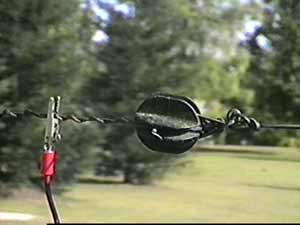 The "egg"
insulator electrically isolates the antenna wire from the
support wire. A simple alligator clip lead connects the
receiver to the antenna. The "egg"
insulator electrically isolates the antenna wire from the
support wire. A simple alligator clip lead connects the
receiver to the antenna.
|
|
48 foot vertical
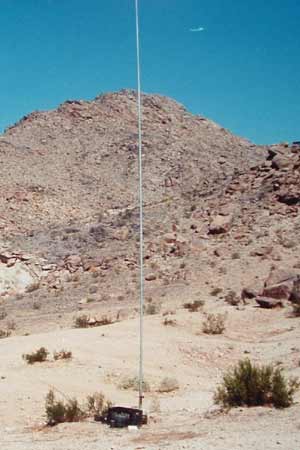
It is made from various
parts, the base is made from parts of a large industrial
computer, a wide milk crate, nuts, bolts, and some hose
clamps. The computer parts are large (23" x 10" x 5/8")
aluminum watercooled heatsinks. They are used for support, we
put counterweights on them to hold it steady. The antenna is
held in place with a short piece of aluminum tubing (1 1/2" x
17") hoseclamped to the milk crate. A fiberglass tube (1 1/2"
Inner dia. x 12") insulates the electrical ground from the
vertical element. The antenna is made up of several sections
of aluminum tubing, starting with 1 1/2" diameter tubing at
the bottom, 1/4" rod at the top. We purchased the antenna
element parts at M2 or M squared Enterprises. Mike Staal at M2 (
www.m2inc.com) helped select
the parts we needed to have a good, strong
antenna. It takes about 15 minutes to set up, and about 10 to
break it down. |
B-field Loop
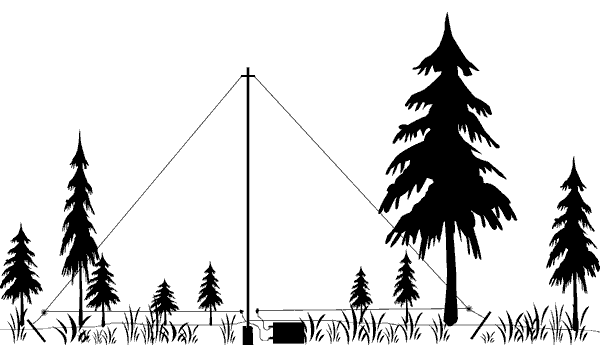
The loop antenna is made for receiving
the magnetic (B-field) component of VLF emissions. It
has the advantage in heavily forested areas,
unlike E-field antenna reception, the loop is
not affected by trees, shrubs or other vegetation.
Another remarkable benefit is that a loop receives
signals bi-directionally. Therefore, one could hear VLF
emissions in stereo by setting up two
loop antennas at right angles of each other.
|